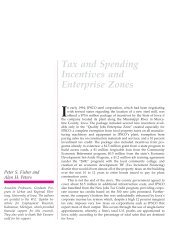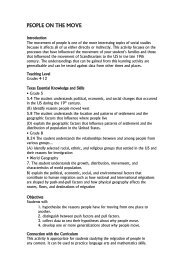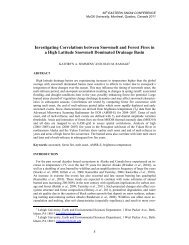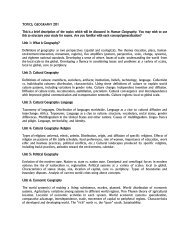Texas Social Studies Framework - Department of Geography ...
Texas Social Studies Framework - Department of Geography ...
Texas Social Studies Framework - Department of Geography ...
Create successful ePaper yourself
Turn your PDF publications into a flip-book with our unique Google optimized e-Paper software.
Chapter 5: The Teaching-Learning System: Curriculum, Instruction, and Assessment<br />
Collaborative<br />
Learning<br />
Techniques<br />
Roundrobin<br />
Corners<br />
Numbered<br />
Heads<br />
Together<br />
Pairs Check<br />
Three Step<br />
Interview<br />
Think Pair<br />
Share<br />
Team Word<br />
Webbing<br />
In, Out, and<br />
Around<br />
(Inside,<br />
Outside,<br />
Circle)<br />
Co-op<br />
Figure 23: Collaborative Learning Techniques<br />
Collaborative Learning Definitions<br />
49<br />
49<br />
Each student in turn shares something with his or her teammates, This works well for expressing<br />
ideas and opinions. Example: Students can use this technique to develop consensus on the<br />
civic responsibilities <strong>of</strong> <strong>Texas</strong> citizens (TEKS 7.16.B).<br />
Students move to designated corners <strong>of</strong> the room and assume an outlook or topic predetermined<br />
by the teacher. Students discuss within corners, then listen to and paraphrase ideas from<br />
other corners. Example: Students can use this activity to compare the ideas from the English,<br />
American, French, and Russian revolutions (World History 8.B).<br />
The teacher asks a question, students consult to make sure that they all know the answer, then<br />
one student is called upon to answer. Example: A group <strong>of</strong> students can discuss the impact <strong>of</strong><br />
scientific discoveries and technological innovations on the United States, making sure everyone<br />
knows a variety <strong>of</strong> examples. Then, the teacher calls upon individual group members to<br />
assess learning (U.S. History 22.A).<br />
Students work in pairs within groups <strong>of</strong> four. Within pairs, one student answers a question/<br />
completes a task while the other coaches. They alternate responsibilities. After every two questions,<br />
the pair checks to see if they have the same answers as the other pair in the group <strong>of</strong> four.<br />
Example: Students can use this technique to review state and national symbols (TEKS 2.14.B).<br />
Students take turns interviewing each other in pairs. Students each share with the group<br />
information they learned in the interview. Example: At the conclusion <strong>of</strong> a unit on how people<br />
have adapted to and modified the <strong>Texas</strong> environment, students interview each other to discover<br />
how they use natural resources to meet basic needs (TEKS 4.9.B).<br />
Students think to themselves on a topic provided by the teacher; they pair up with another<br />
student to discuss it; then they share their thoughts with the class. Example: Students can be<br />
asked to give examples <strong>of</strong> the processes used by individuals, political parties, interest groups<br />
or the media to affect public policy. After quiet thought, they share with a neighbor, then the<br />
entire class (U.S. Government 3.B).<br />
Students write simultaneously on a piece <strong>of</strong> butcher paper, drawing main concepts, supporting<br />
elements, and bridges representing the relation <strong>of</strong> concepts in a generalization. This helps<br />
students to analyze and to see relationships in complex systems. Example: Students can be<br />
asked to compare the historical origins, traditions, and spread <strong>of</strong> major religions and philosophical<br />
ideas (World History 19.A).<br />
Students stand in two concentric circles. The inside circle faces out, the outside circle in.<br />
Students use flash cards or respond to teacher questions as they rotate to each new partner.<br />
This helps students review and process information and assesses understanding. Example:<br />
Students can be asked to explain the significance <strong>of</strong> selected ethnic and/or cultural celebrations<br />
(TEKS 3.12.A).<br />
Students work in groups to produce a particular product. Example: Students can prepare<br />
production-possibilities curves, circular-flow charts, and supply-and-demand graphs (Economics<br />
23.B) to share with the whole class; each student makes a particular contribution to the group.
















